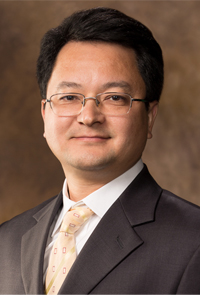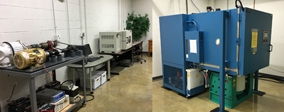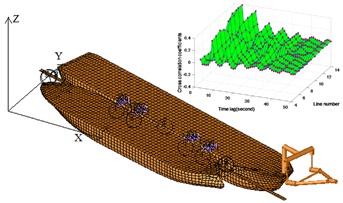Department of Industrial Engineering
4207 Bell Engineering Center
1 University of Arkansas
Fayetteville, AR 72701
Phone: (479) 575-3156
Fax: (479) 575-8431
Research Frontiers in Reliability Engineering and Service Logistics
 Dr. Haitao Liao Explores Research Frontiers in Reliability Engineering and Service
Logistics
Dr. Haitao Liao Explores Research Frontiers in Reliability Engineering and Service
Logistics
The advances and increasing complexities of new technologies require fundamental methodologies to minimize adverse economic and operational impacts of unexpected failures of engineering systems. For instance, it is often expected that a product, as small as a cutting tool used in machining or as massive as a 10 megawatt wind turbine, can operate reliably and be maintained in a timely fashion. However, product reliability and service logistics usually do not reconcile due to various uncertainties. Unfortunately, methodologies that reduce various uncertainties in product reliability and service logistics have been developed in segments. As a result, decisions on maintenance and procurement of service parts are made either too late or too early. In Liao’s Reliability and Intelligent Systems Engineering (RISE) Laboratory, research efforts are being taken to create holistic tools that will enable accurate reliability estimation, proactive control of product reliability and operational adjustments to adaptively coordinate product reliability and service logistics, so that the overall uncertainty can be reduced more effectively and globally.

The questions that must be answered are (1) how to reduce the uncertainty in product reliability estimation prior to and during operation, (2) how to control product reliability in real time in complex engineering settings, and (3) how to determine the maintenance strategy and refine the associated service logistic process by incorporating the product reliability being controlled. Liao’s research group has been investigating the answers to these questions through both experimental and analytical studies.
 In RISE, to estimate and improve product reliability, different types of reliability
tests at material and component levels can be conducted. The applications include
nanomaterials, microelectronics, machine tools, and gearboxes. The newly established
lab space at the University of Arkansas Engineering Research Center houses a combined
environmental testing facility that provides product designers with a full spectrum
of analysis on the potential failure modes as well as lifetime and/or degradation
data. The team is currently developing a collection of generic models and tools for
analyzing accelerated life or degradation testing data involving complex covariates.
Moreover, their previous research on reducing the energy consumption of such reliability
tests will make the implementation of testing strategies and data analysis more attractive.
Indeed, by precisely knowing the reliability of a product under different and time-varying
operating conditions and prognostics - condition-based maintenance and proactive service
logistics can be carried out more effectively than ever before.
In RISE, to estimate and improve product reliability, different types of reliability
tests at material and component levels can be conducted. The applications include
nanomaterials, microelectronics, machine tools, and gearboxes. The newly established
lab space at the University of Arkansas Engineering Research Center houses a combined
environmental testing facility that provides product designers with a full spectrum
of analysis on the potential failure modes as well as lifetime and/or degradation
data. The team is currently developing a collection of generic models and tools for
analyzing accelerated life or degradation testing data involving complex covariates.
Moreover, their previous research on reducing the energy consumption of such reliability
tests will make the implementation of testing strategies and data analysis more attractive.
Indeed, by precisely knowing the reliability of a product under different and time-varying
operating conditions and prognostics - condition-based maintenance and proactive service
logistics can be carried out more effectively than ever before. In addition to developing mathematical models and statistical tools for solving prognostics
and service part inventory control problems, the team is currently focusing more on
the reliability and resilience of condition monitoring (CM) systems with multiple
sensors. Such systems have been widely implemented to ensure the reliability and safety
of engineering systems, such as nuclear power plants, bridges, and offshore oil offloading
system. However, an ironic issue commonly faced by engineers is that the sensors in
such CM systems are often less reliable than the systems to be monitored. Moreover,
harmful disturbances, such as cyber and/or natural attacks, can also cause sensor
failures. Upon the loss of sensor signal(s), a technical challenge is to determine
whether or not it is due to sensor failures or to the failure of the systems being
monitored. In the case of sensor failure, one way to enhance the dependability of
a CM system is to enable its resilience capability, and quickly recover from single
or multiple sensor failures. To this end, the spatio-temporal relationships among
multiple sensors need to be investigated, and the most effective recovery strategy
must be identified in hopes of achieving nearly uninterrupted operation. The team
has been working on different signal processing methods, such as wavelet decomposition,
and machine learning approaches to identify sensor failures and enable signal prediction
based on the available data from multiple sensor signals. The goal is to provide an
effective method that balances the response time and the accuracy and precision of
signal recovery. The methodology has been tested on a case study on hawser CM in a
Floating Production, Storage and Offloading (FPSO) system.
In addition to developing mathematical models and statistical tools for solving prognostics
and service part inventory control problems, the team is currently focusing more on
the reliability and resilience of condition monitoring (CM) systems with multiple
sensors. Such systems have been widely implemented to ensure the reliability and safety
of engineering systems, such as nuclear power plants, bridges, and offshore oil offloading
system. However, an ironic issue commonly faced by engineers is that the sensors in
such CM systems are often less reliable than the systems to be monitored. Moreover,
harmful disturbances, such as cyber and/or natural attacks, can also cause sensor
failures. Upon the loss of sensor signal(s), a technical challenge is to determine
whether or not it is due to sensor failures or to the failure of the systems being
monitored. In the case of sensor failure, one way to enhance the dependability of
a CM system is to enable its resilience capability, and quickly recover from single
or multiple sensor failures. To this end, the spatio-temporal relationships among
multiple sensors need to be investigated, and the most effective recovery strategy
must be identified in hopes of achieving nearly uninterrupted operation. The team
has been working on different signal processing methods, such as wavelet decomposition,
and machine learning approaches to identify sensor failures and enable signal prediction
based on the available data from multiple sensor signals. The goal is to provide an
effective method that balances the response time and the accuracy and precision of
signal recovery. The methodology has been tested on a case study on hawser CM in a
Floating Production, Storage and Offloading (FPSO) system.
Dr. Haitao Liao is a Professor and Hefley Endowed Chair in Logistics and Entrepreneurship in the Department of Industrial Engineering at University of Arkansas. He received a Ph.D. degree in Industrial and Systems Engineering from Rutgers University in 2004. His research has been sponsored by the National Science Foundation, Department of Energy, Nuclear Regulatory Commission, Oak Ridge National Laboratory, and industry. In 2014, he served as Chair of INFORMS Quality, Statistics and Reliability (QSR) Section, and President of IIE Quality Control and Reliability Engineering (QCRE) Division. He currently serves as Associate Editor for the Journal of Quality Technology and IISE Transactions on Quality and Reliability Engineering.